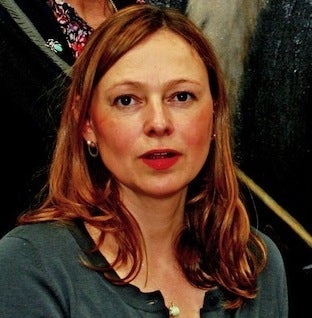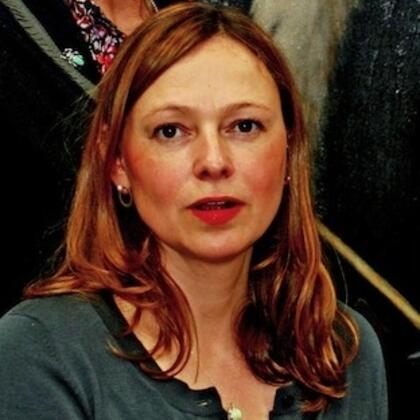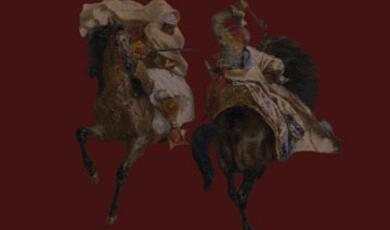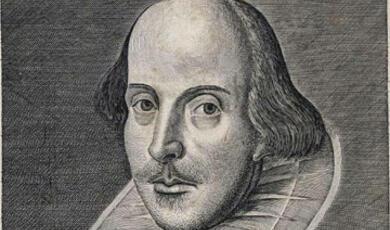Making Art in Tudor Britain
Share
- Details
- Transcript
- Audio
- Downloads
- Extra Reading
An exploration of the environment in which art was produced in Tudor Britain, and an investigation of what lessons we may learn about the period through this art.
Download Transcript
MAKING ART IN TUDOR BRITAIN
Dr Tarnya Cooper
The title of this lecture was Making Art in Tudor Britain, but who thought they were making Art in sixteenth-century England and did the concept even exist? Most painters considered themselves artisans rather than artists and the idea of the single creative genius is not relevant to sixteenth-century Britain. Painting was certainly not the only or most dominant form of what we think of as art today. Painters were paid the same or even less than carpenters or saddlers (and much less than goldsmiths).
The majority of the surviving painted material from the Tudor period is in the form of painted panel portraits. Yet, we know from surviving documentary sources that Tudor artists were heavily engaged in other types of painting including the production of banners and set designs for ephemeral court events and decorative designs for interiors on plaster, wood and canvas, the vast majority of which no longer survives. Therefore portraiture represents most of the remaining material evidence for the production of painted imagery in this period.
The National Portrait Gallery has the largest public collection of Tudor paintings, with around 240 works currently catalogued as sixteenth-century (a fraction of what was produced but a significant proportion of what remains - up to 60 percent of production may have been lost). The vast majority of Tudor paintings are unsigned and a very large number are un-attributable, as it is extremely difficult to identify the names and specific oeuvres of artists.[1] Even outstandingly accomplished sixteenth-century paintings are often difficult to link securely with painters. Documentary sources concerning individual artists in this period are extremely limited, and even more so for those working outside the court environment.[2] Consequently, many paintings become known as 'English school' or 'Anglo Netherlandish'. More optimistically some can be identified as 'Studio of' one of the very few known artists such as the émigré artists Hans Holbein, Hans Eworth and William Scrots, or the English painters George Gower or Nicholas Hilliard. The reality is that most surviving paintings are not by these well-known artists but a multitude of other un-identifiable painters. Occasionally it is possible to link un-attributed pictures as being made by the same artist or studio. Also some individual pictures sometimes have names attached to them through documentary sources such as inventories. (For example the National Portrait Gallery portrait of Mary I by Master John, NPG 428, and the portrait of William Shakespeare by John Taylor, NPG1).
The Mercer's portrait of Thomas Gresham, dated 1544 is a good introduction to citizen portraiture in England, as one of the earliest English merchant portraits. It was made at a time when visual imagery was far less common that today and when portraiture in England was a reasonably new concept. The dates of portraits of ordinary citizens (rather than courtiers) frequently coincides with significant events or periods in their own personal biography, indicating the exercise of choice, and desire to mark individual circumstances. Common reasons to commission portraits include marriage, the secure establishment of their worldly success such as entry into the Livery of a city company or the purchase of property leases, and occasionally the death of a spouse, sibling, or child.
The year 1544 when this portrait was commissioned was significant for Gresham in many ways
- He was admitted to the Livery of the Mercers' company, an élite body within the company.
- He began trading on his own account in Antwerp.
- He married Anne Fernely, daughter of William Fernely and widow of another Mercer, William Read.
At this stage Gresham was aged 24, from a family of lesser gentry and a partner in his father's successful business empire. He must also have been extremely young confident man who impressed audiences on first meeting. He spoke French, Flemish and Latin ably and at the age of just 20 he was employed on crown errands in the Netherlands. He was also a risk taker - in his business of exporting wool and importing weaponry and luxury cloth he quickly started trading in extremely large sums: he scaled up operations to quantities of thousands rather than the hundreds as his father had imported.
[1] While few signatures are in evidence, the 1582 ordinances of the Painter Stainers Company demanded that all work to be sold in shops and markets 'be marked with the mark of the house' and one penny was payable to the company for every such work marked. Englefield, 1923, p.73. It is certainly possible that this payment functioned as a disincentive to painters in London to mark or sign works.
[2] See for example: Albert Fueillerat's Documents relating to the Revels..,1908 and Erna Auerbach's study Tudor Artists. A study of painters in royal service and portraiture on illuminated documents from the Accession of Henry VIII to the death of Elizabeth I, London: The Athlone Press, 1954.
There are several remarkable things about this portrait: The full length format, the inscription, the skull at the base and the technical virtuosity of painter - and I am going to touch on these in turn.
Full Length Format
The full-length format was still rare in England (as elsewhere in Europe) at this period, and was generally used for portraits of royal sitters - see Henry VIII, Holbein cartoon of c.1536-7, NPG 4027. The representation of an entire sitter in this full-length life-size portrait duplicates the whole body (and becomes another self). In this way it is a counterfeit or copy of the person (this is the word regularly used to refer to portraits in the sixteenth-century - the duplicity of imagery - fake reality).
Gresham's picture is the first portrait of a (a non-royal) British sitter in the full-length format. The relatively modest status of Thomas Gresham as a young, fledgling merchant and the highly unusual and elaborate full-length depiction can perhaps be reconciled by considering Gresham's irrepressibly ambitious personality.
Inscription
The portrait was designed to commemorate significant events in the life of the sitter and these are celebrated in the inscriptions and marks placed either side of the figure. To the right his merchant's mark has been painted upon a stone wall; a highly identifiable insignia of initials, which he also used on official documentation.[3] (Gresham used his merchant mark even though the family had a coat of arms - this was more a celebration of the means of his livelihood, rather than apeing the nobility)
Marriage
It has been suggested that this painting may have been part of a double marriage portrait, however the composition of the image and the central placing of figure makes this hypothesis improbable. To the right (where Anne would traditionally be placed in a double portrait) is written 'AG. love serve and obey TG' and these words convey their meaning like a spoken promise from vacant Anne to Thomas. Therefore if this image was originally designed as one part of a pair, Gresham would appear to be turning away from his new wife and his looming shadow would be at the centre of the pendant composition. It is more probable that this image was commissioned as a single portrait to celebrate a highly significant year in a young man's life. The portrait was in all likelihood brought back to England during Gresham's lifetime and may even have been sent within the year as either a betrothal or marriage gift to his wife in England in anticipation or remembrance of their vows.[4]
Skull at base
The device of the skull lying upon its side was designed to sound a note of humility and counterbalance this rather lavish presentation of the worldly body. Skulls and other tokens of mortality and passing time (clocks, hourglasses, and skeletons) were reasonably common visual motif in portraiture, and particularly appear in portraits of those outside the nobility such as merchants and other middling sorts.
The skull also functions as a spiritual token that serves to deny the value of worldly existence and effectively offer a form of deference to spiritual values over worldly existence - an extremely interest motif for a man engaged in the full scale pursuit of wealth.
Costume
Merchants commonly wore black clothes - an apparently a non-showy practical choice. Yet black dye was expensive true blacks difficult to achieve, so black cloth was a costly choice. Even so there were blacks and blacks - expensive black cloth such as satin and velvet had a lustrous feel and rich appearance. Therefore even in wearing appropriate merchant costume there would have been ways to stand out from a crown. Gresham seems to be illustrating this here by wearing black brocaded fabric with a possible floral motif and silver thread in the collar - he was a man who traded in cloth so he presumably knew the best suppliers.
[3] This feature is a very rare inclusion in a portrait of this period. Another, far later example also appears in a memento mori portrait, depicting a merchant and his family, Triptych of Paul and Dorothy Holme with their Two Children , dated 1629 (A.72) also includes the sitter's merchant's mark. Gresham's merchant's mark is also used by him throughout his personal account book held at the Mercers' Company Archive.
[4] The portrait was formerly owned by the Thurston Family at Hoxne Abbey, Suffolk, which was Gresham's former home, a Benedictine priory granted to his father Richard Gresham. Burgon, (1834). The portrait was most likely brought back to England either shortly after it was completed or at least before his death in 1579.
The painter
Gresham probably had numerous links with Antwerp artists and while it has not been possible to confidently attribute this painting to an artist (partly because of extensive damage to surface), he chose an extremely competent painter. The picture is certainly by a Netherlandish artist, not by Holbein as noted on the nineteenth-century frame (who was dead by 1543). One possibility is the painter Guilliam Scrots who painted several portraits of Edward VI (although recent technical research does not show a resemblance between the style of painting in the two portraits - however more research is needed). Although Gresham had a house in Antwerp, the picture likely returned to England in his lifetime and may have been seen either at his house at Lombard Street, or his estates outside London.
London merchants
In London and some other urban centres merchants, lawyers, physicians, and other professionals began to commission individual painted portraits from the 1550s onward. There are numerous factors that affected the increased access to portrayal among these groups. Growth in affluence, personal confidence and increased opportunities for speedy self enhancement played a role, as did indeed the emphasis the protestant religion placed upon individual aspects of a personal relationship with God. But perhaps more important than any of this was the influence of foreign, and particularly Netherlandish artists working in London (such as Hans Eworth, Steven van Muelen or Cornelis Visscher). Of course, the use of foreign artists at court and expansion of court portraiture established models to emulate at home. Within the London mercantile context, it may have been the interaction between the émigré merchants settled in London and émigré painters that also set precedents and popularised the genre.
New research on Tudor portraits at the National Portrait Gallery
In April 2007 the National Portrait Gallery began a major research project that will help to transform understanding of early painting practice and the production of portraits in the Tudor and Jacobean periods. The project will involve a detailed and comprehensive scientific survey of over 80 of the most important portraits from the Gallery's collection in the period 1500-1620.
The techniques employed included infrared reflectography (to identify layers beneath the paint surface and underdrawing), dendrochronology (or tree ring dating), paint sampling (to help identify pigments, layer structures and help with dating), x-ray and microscope analysis. When used in unison, the tools of technical analysis can provide a comprehensive understanding of the techniques, methods of production, and later alterations in an individual picture.
So what can technical analysis teach us about painting in this period? For example, what can the identification of underdrawing or the presence of a specific pigment actually tell us? The most obvious answer relates to dating and attribution of paintings. The tools of technical analysis also have the capacity to explore the creative process and reveal some of the original intentions of the artist, providing evidence about the original appearance, the use of presentational devices such as lost frames or covers, or changes in the colour values of pigments. In reference to portraiture, technical study can help to assess the status of likeness, and although this area needs extremely careful interpretation, underdrawings can help to indicate the source of the composition and whether a carefully established pattern or detailed drawing has been employed.
For further examples of recent findings see:
http://www.npg.org.uk/live/makingtudorartworkshop.asp
http://www.npg.org.uk/live/makingtudorartcasestudies.asp
Research on Gresham portrait
Damaged condition
The picture has suffered from considerable damage in the past and whole parts have been repainted. The damage suffered is the key problem in trying to identify the particular artist who painted it. An x-ray shows screws and supporting wood on the back of the panel, as well as the damage and losses to the face.
Inscription
This has been overpainted at a later date to strengthen the lines of the lettering.
Changes to the eyes
It is not known at what stage this occurred - perhaps Gresham returned for a final sitting or maybe the artist made the adjustments by looking again at the facial proportions. This occasionally occurs with other artists, for example the portrait of John Donne, NPG 6790.
Adjustments to the Figure
The figure would probably have been drawn in with chalk or brush and ink, however it was not possible to identity any specific underdrawing, except for touches in the face (i.e. the eyebrows). There were also changes made to the skull, leg and feet positioning.
Dendrochronology:
The three boards were measured - findings suggest that they all derive from different oak trees that grew in the Eastern Baltic region. Board A's last ring suggests a date of 1520, board B 1515 and board C 1527. Adding the minimum numbers of wood rings it seems the boards cannot have been felled before 1535 (nine years before they were probably used for this portrait).
I am grateful to my colleagues in our conservation department particularly Sophie Plender and external specialists Kate Stoner, Clare Richardson, Libby Sheldon and Ian Tyers for much of the information in this lecture.
©Dr Tarnya Cooper, Gresham College, 22 May 2008
Part of:
This event was on Thu, 22 May 2008
Support Gresham
Gresham College has offered an outstanding education to the public free of charge for over 400 years. Today, Gresham plays an important role in fostering a love of learning and a greater understanding of ourselves and the world around us. Your donation will help to widen our reach and to broaden our audience, allowing more people to benefit from a high-quality education from some of the brightest minds.


 Login
Login











